Families of dicotyledons Apiaceae Euphorbiaceae Fabaceae Rosaceae Solanaceae


Families of dicotyledons Apiaceae Euphorbiaceae Fabaceae Rosaceae Solanaceae
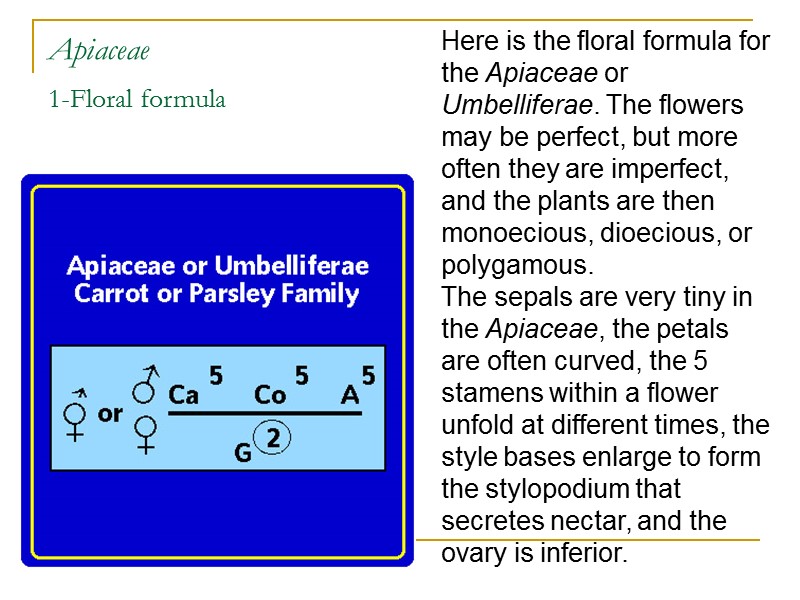
Apiaceae 1-Floral formula Here is the floral formula for the Apiaceae or Umbelliferae. The flowers may be perfect, but more often they are imperfect, and the plants are then monoecious, dioecious, or polygamous. The sepals are very tiny in the Apiaceae, the petals are often curved, the 5 stamens within a flower unfold at different times, the style bases enlarge to form the stylopodium that secretes nectar, and the ovary is inferior.
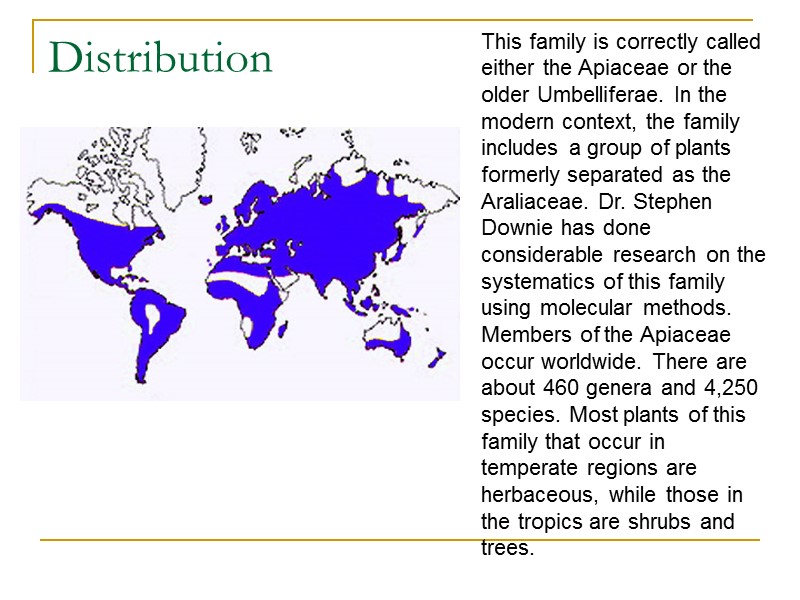
Distribution This family is correctly called either the Apiaceae or the older Umbelliferae. In the modern context, the family includes a group of plants formerly separated as the Araliaceae. Dr. Stephen Downie has done considerable research on the systematics of this family using molecular methods. Members of the Apiaceae occur worldwide. There are about 460 genera and 4,250 species. Most plants of this family that occur in temperate regions are herbaceous, while those in the tropics are shrubs and trees.
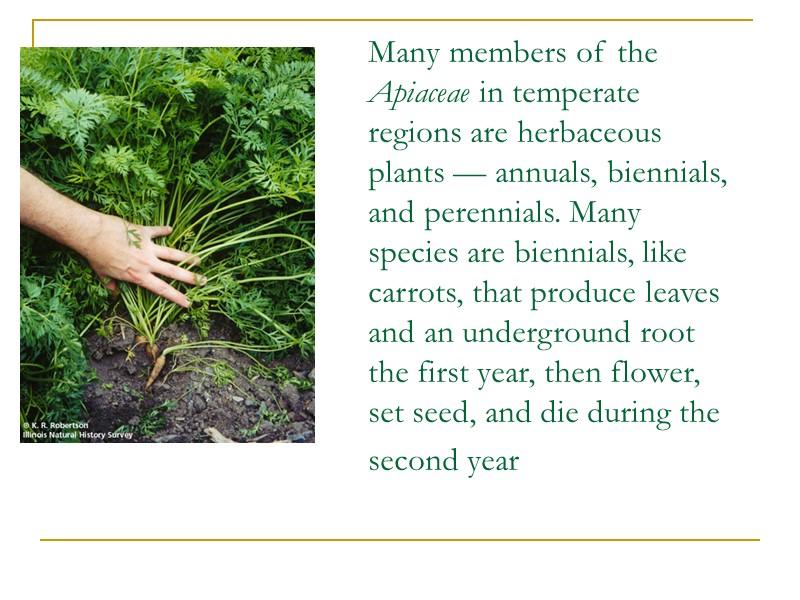
Many members of the Apiaceae in temperate regions are herbaceous plants — annuals, biennials, and perennials. Many species are biennials, like carrots, that produce leaves and an underground root the first year, then flower, set seed, and die during the second year
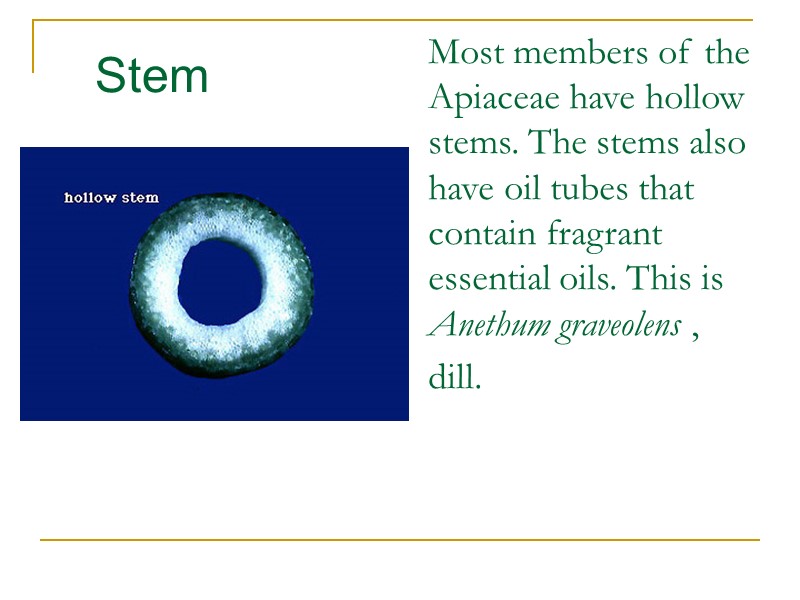
Most members of the Apiaceae have hollow stems. The stems also have oil tubes that contain fragrant essential oils. This is Anethum graveolens , dill. Stem
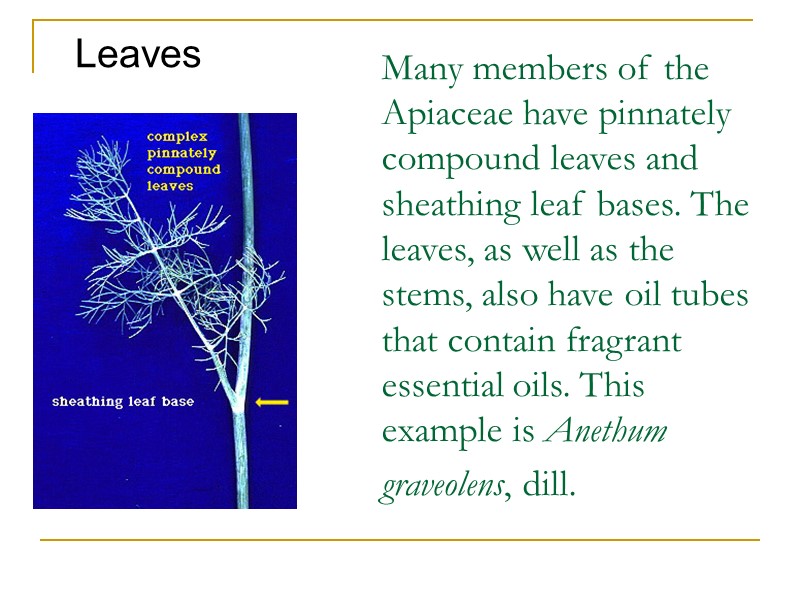
Many members of the Apiaceae have pinnately compound leaves and sheathing leaf bases. The leaves, as well as the stems, also have oil tubes that contain fragrant essential oils. This example is Anethum graveolens, dill. Leaves
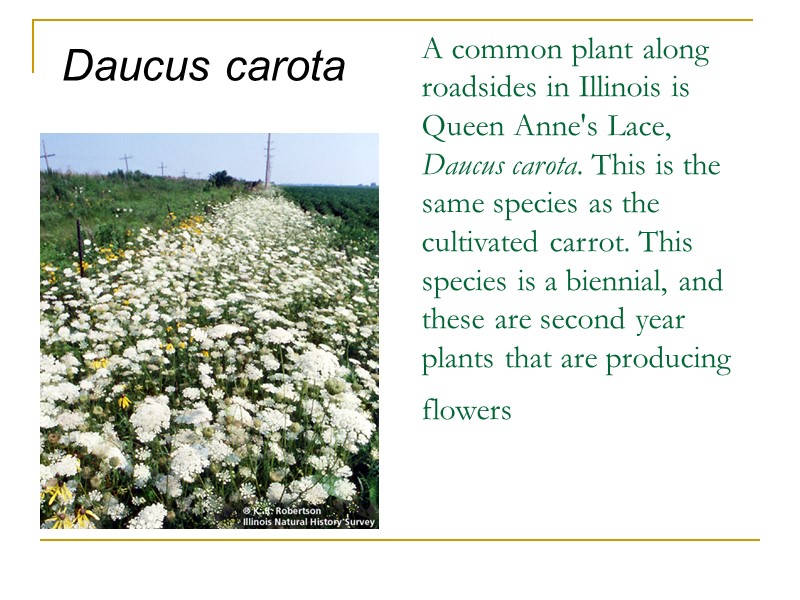
A common plant along roadsides in Illinois is Queen Anne's Lace, Daucus carota. This is the same species as the cultivated carrot. This species is a biennial, and these are second year plants that are producing flowers Daucus carota
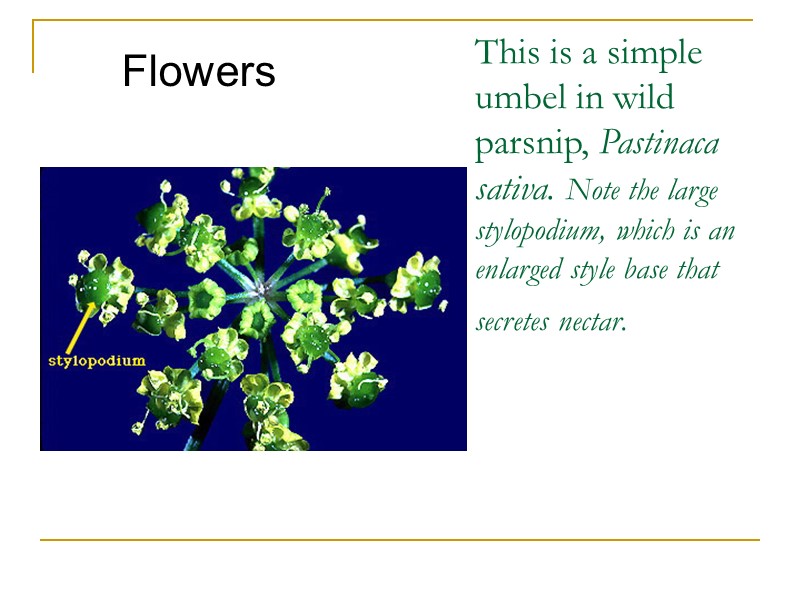
This is a simple umbel in wild parsnip, Pastinaca sativa. Note the large stylopodium, which is an enlarged style base that secretes nectar. Flowers
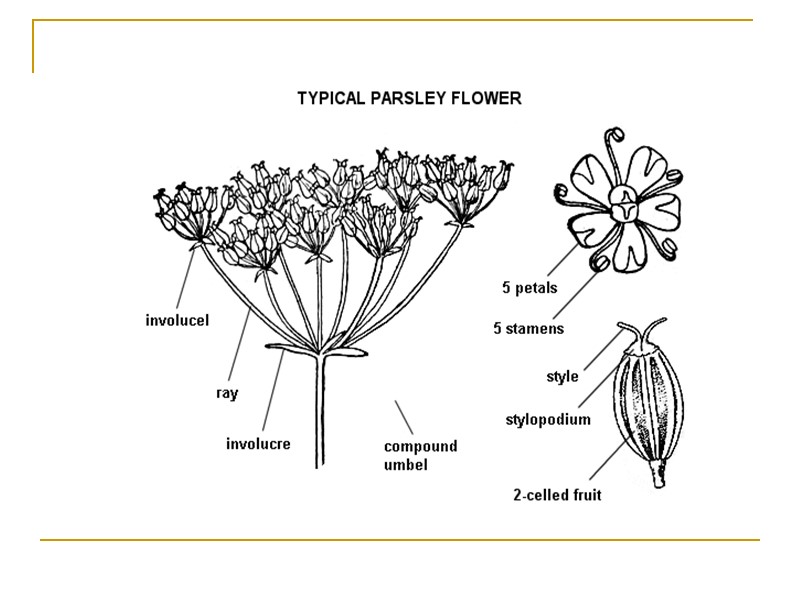
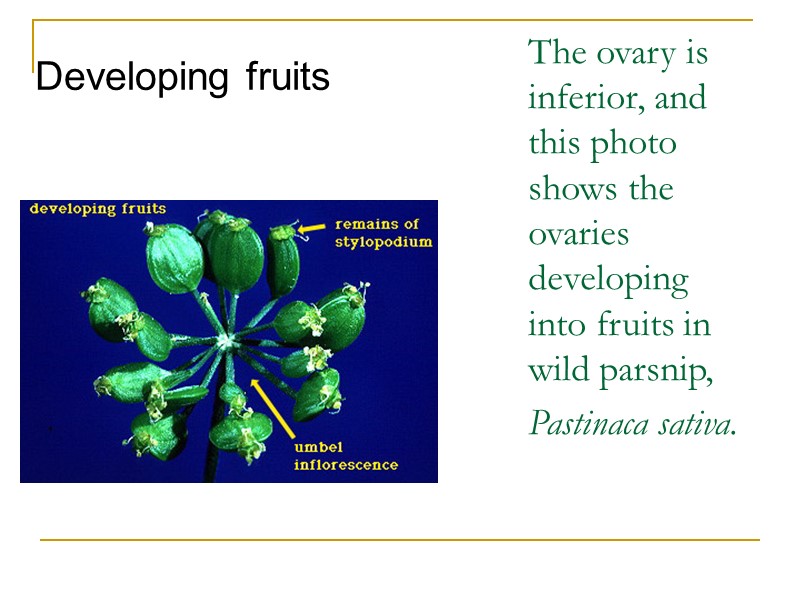
The ovary is inferior, and this photo shows the ovaries developing into fruits in wild parsnip, Pastinaca sativa. Developing fruits
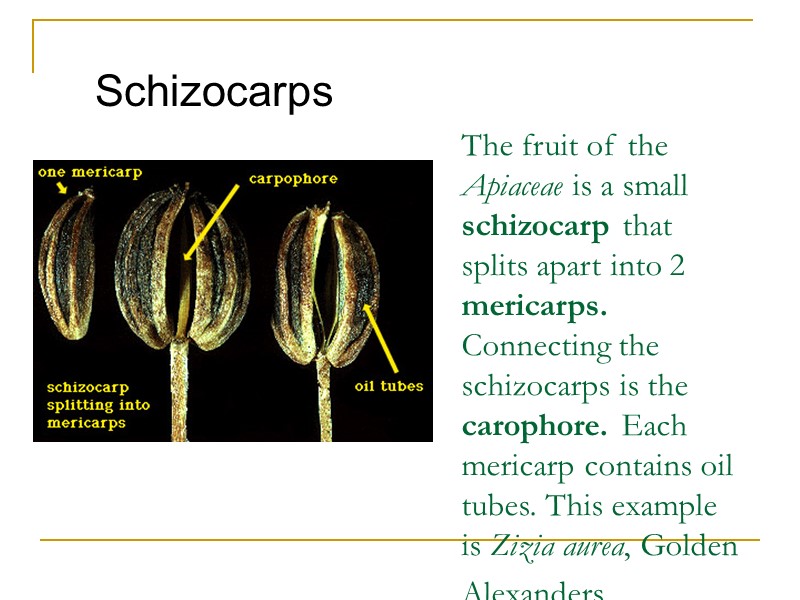
The fruit of the Apiaceae is a small schizocarp that splits apart into 2 mericarps. Connecting the schizocarps is the carophore. Each mericarp contains oil tubes. This example is Zizia aurea, Golden Alexanders. Schizocarps
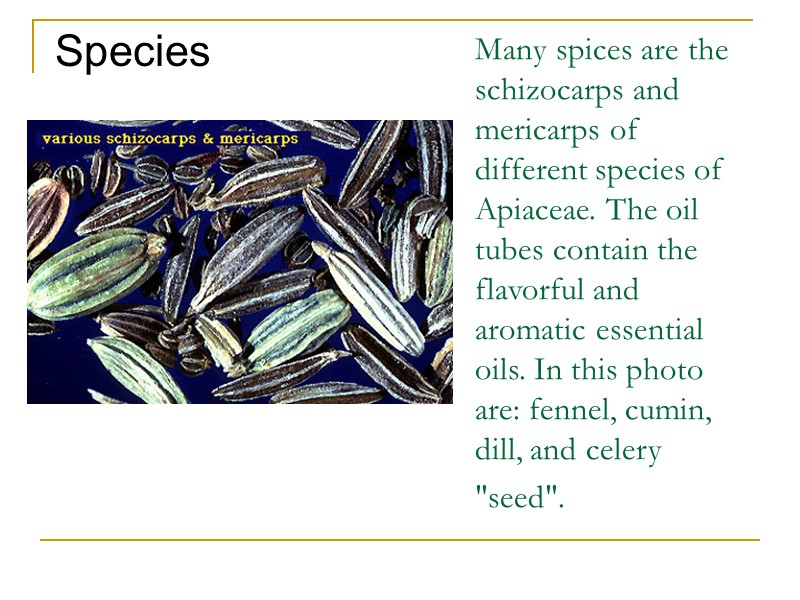
Many spices are the schizocarps and mericarps of different species of Apiaceae. The oil tubes contain the flavorful and aromatic essential oils. In this photo are: fennel, cumin, dill, and celery "seed". Species
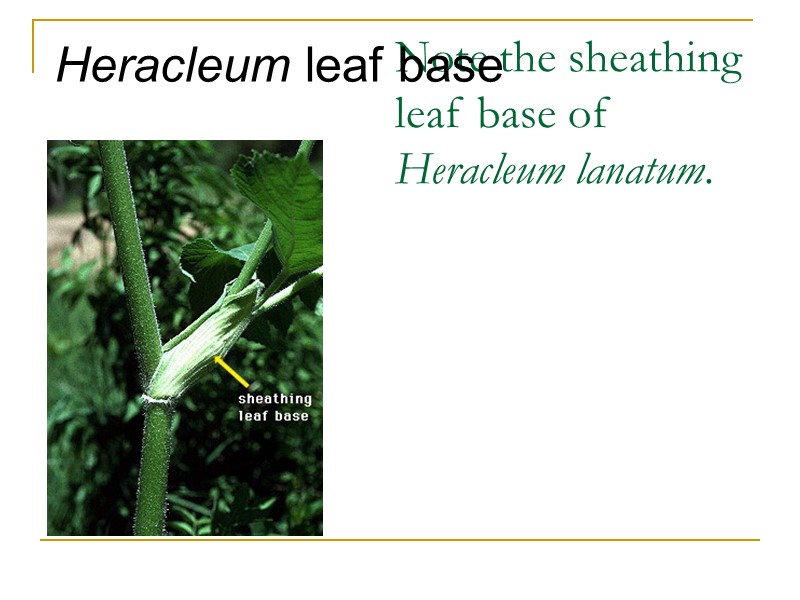
Note the sheathing leaf base of Heracleum lanatum. Heracleum leaf base
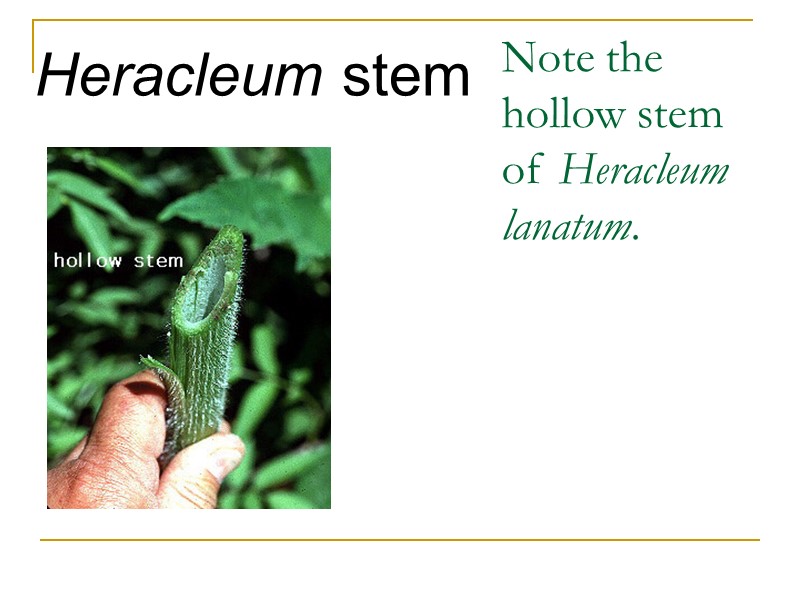
Note the hollow stem of Heracleum lanatum. Heracleum stem
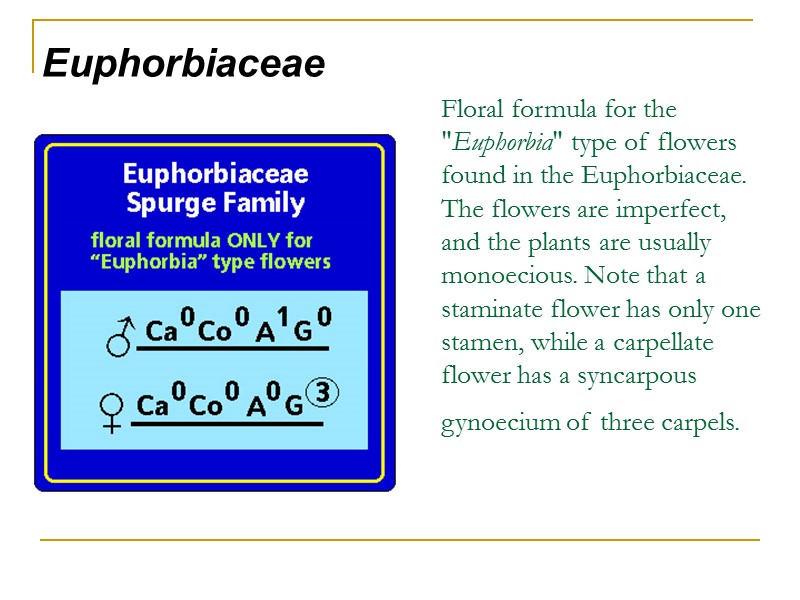
Floral formula for the "Euphorbia" type of flowers found in the Euphorbiaceae. The flowers are imperfect, and the plants are usually monoecious. Note that a staminate flower has only one stamen, while a carpellate flower has a syncarpous gynoecium of three carpels. Euphorbiaceae
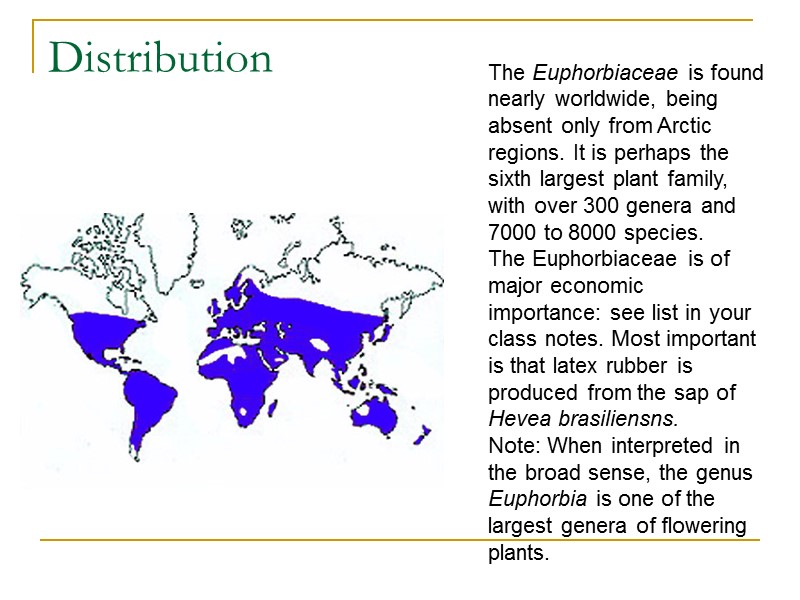
Distribution The Euphorbiaceae is found nearly worldwide, being absent only from Arctic regions. It is perhaps the sixth largest plant family, with over 300 genera and 7000 to 8000 species. The Euphorbiaceae is of major economic importance: see list in your class notes. Most important is that latex rubber is produced from the sap of Hevea brasiliensns. Note: When interpreted in the broad sense, the genus Euphorbia is one of the largest genera of flowering plants.
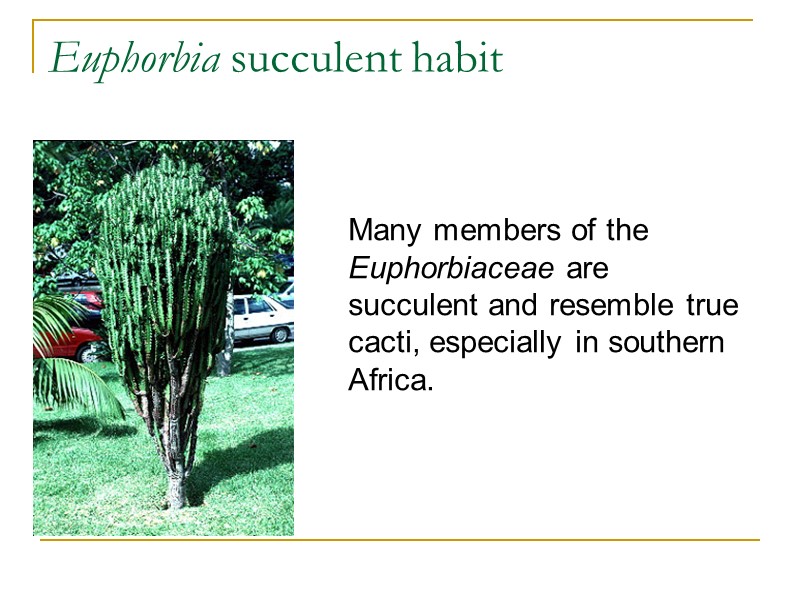
Euphorbia succulent habit Many members of the Euphorbiaceae are succulent and resemble true cacti, especially in southern Africa.
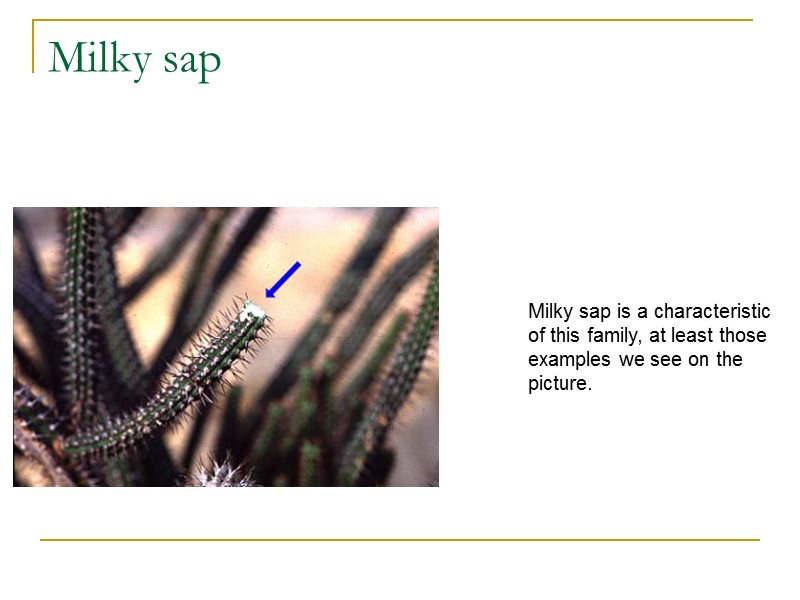
Milky sap Milky sap is a characteristic of this family, at least those examples we see on the picture.
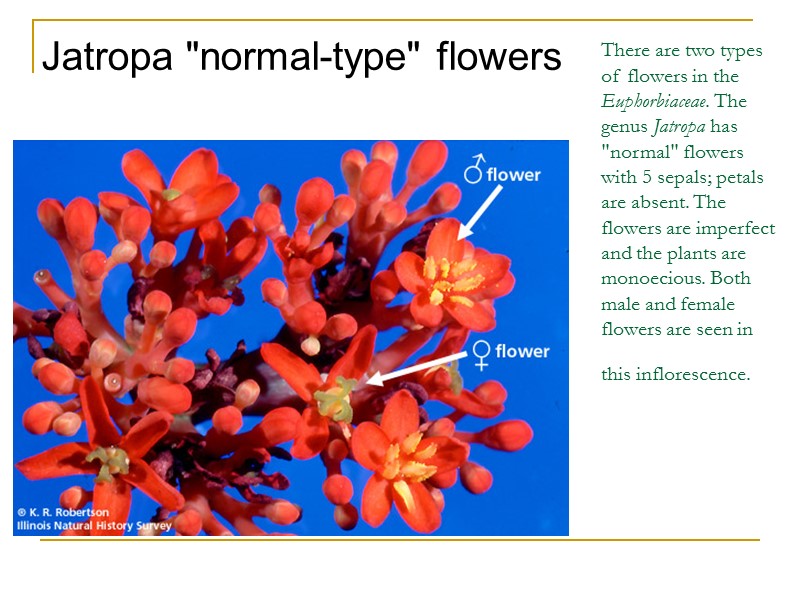
There are two types of flowers in the Euphorbiaceae. The genus Jatropa has "normal" flowers with 5 sepals; petals are absent. The flowers are imperfect and the plants are monoecious. Both male and female flowers are seen in this inflorescence. Jatropa "normal-type" flowers
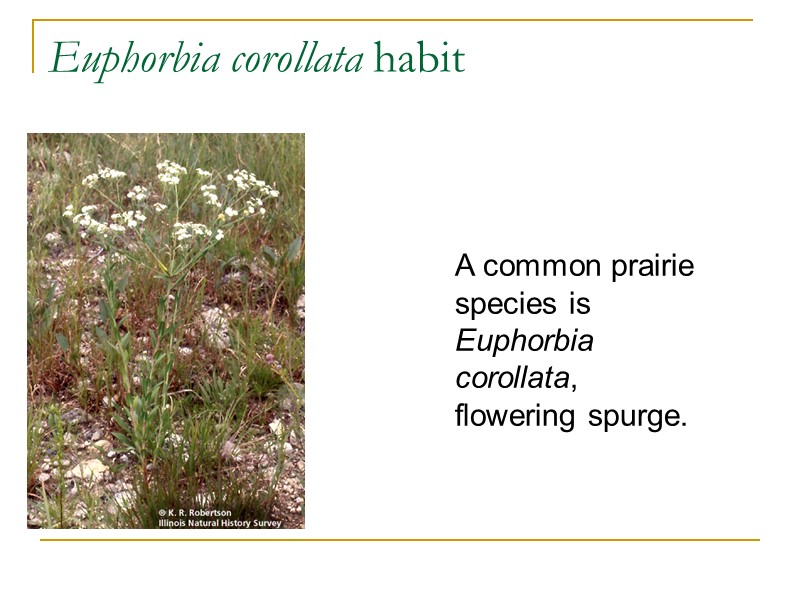
Euphorbia corollata habit A common prairie species is Euphorbia corollata, flowering spurge.
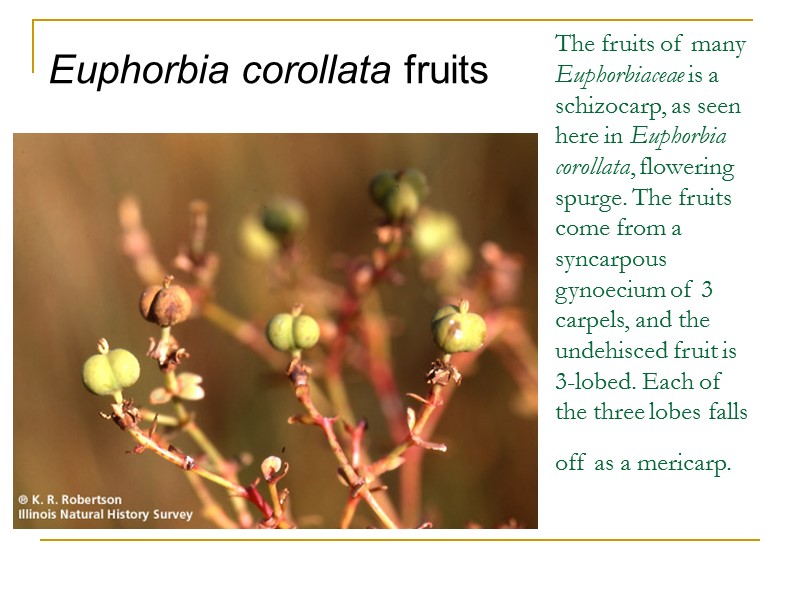
The fruits of many Euphorbiaceae is a schizocarp, as seen here in Euphorbia corollata, flowering spurge. The fruits come from a syncarpous gynoecium of 3 carpels, and the undehisced fruit is 3-lobed. Each of the three lobes falls off as a mericarp. Euphorbia corollata fruits
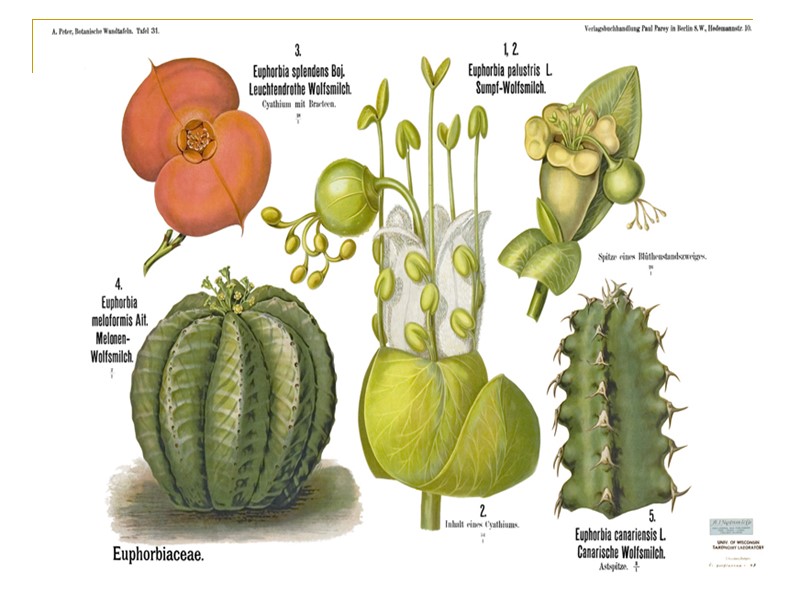
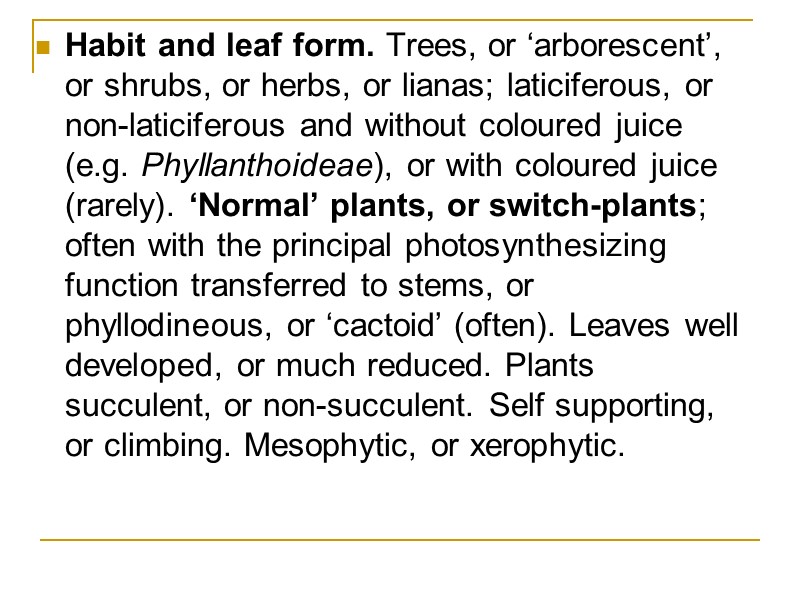
Habit and leaf form. Trees, or ‘arborescent’, or shrubs, or herbs, or lianas; laticiferous, or non-laticiferous and without coloured juice (e.g. Phyllanthoideae), or with coloured juice (rarely). ‘Normal’ plants, or switch-plants; often with the principal photosynthesizing function transferred to stems, or phyllodineous, or ‘cactoid’ (often). Leaves well developed, or much reduced. Plants succulent, or non-succulent. Self supporting, or climbing. Mesophytic, or xerophytic.
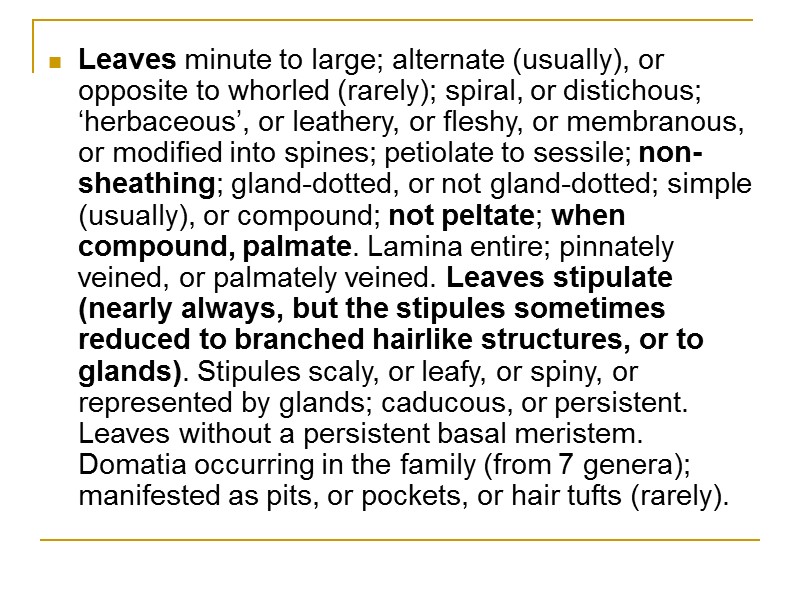
Leaves minute to large; alternate (usually), or opposite to whorled (rarely); spiral, or distichous; ‘herbaceous’, or leathery, or fleshy, or membranous, or modified into spines; petiolate to sessile; non-sheathing; gland-dotted, or not gland-dotted; simple (usually), or compound; not peltate; when compound, palmate. Lamina entire; pinnately veined, or palmately veined. Leaves stipulate (nearly always, but the stipules sometimes reduced to branched hairlike structures, or to glands). Stipules scaly, or leafy, or spiny, or represented by glands; caducous, or persistent. Leaves without a persistent basal meristem. Domatia occurring in the family (from 7 genera); manifested as pits, or pockets, or hair tufts (rarely).
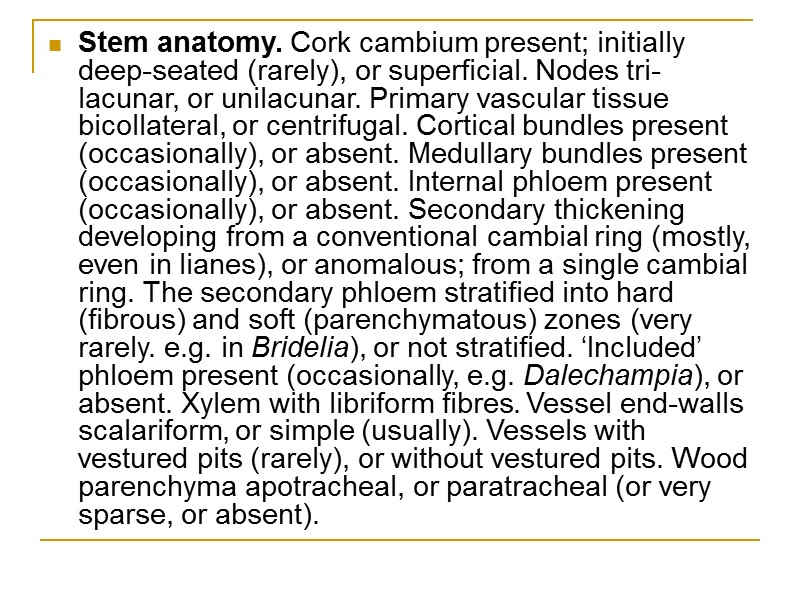
Stem anatomy. Cork cambium present; initially deep-seated (rarely), or superficial. Nodes tri-lacunar, or unilacunar. Primary vascular tissue bicollateral, or centrifugal. Cortical bundles present (occasionally), or absent. Medullary bundles present (occasionally), or absent. Internal phloem present (occasionally), or absent. Secondary thickening developing from a conventional cambial ring (mostly, even in lianes), or anomalous; from a single cambial ring. The secondary phloem stratified into hard (fibrous) and soft (parenchymatous) zones (very rarely. e.g. in Bridelia), or not stratified. ‘Included’ phloem present (occasionally, e.g. Dalechampia), or absent. Xylem with libriform fibres. Vessel end-walls scalariform, or simple (usually). Vessels with vestured pits (rarely), or without vestured pits. Wood parenchyma apotracheal, or paratracheal (or very sparse, or absent).
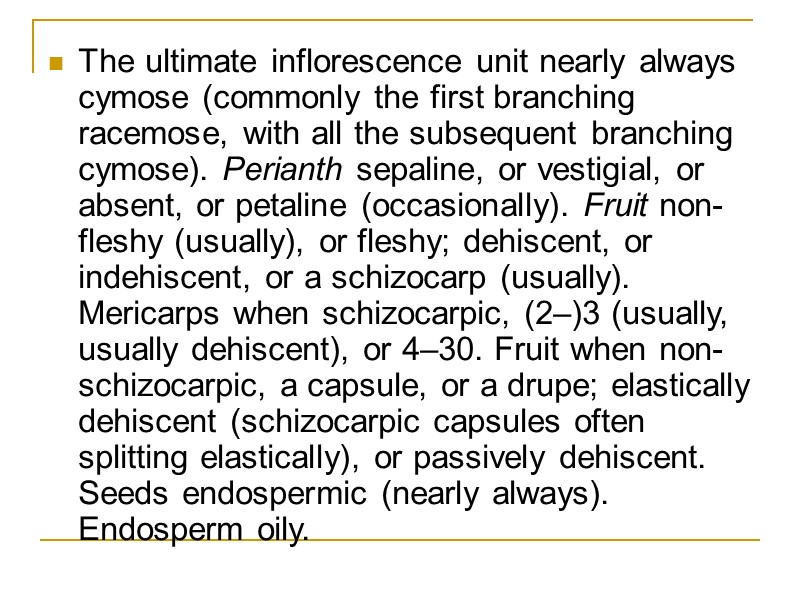
The ultimate inflorescence unit nearly always cymose (commonly the first branching racemose, with all the subsequent branching cymose). Perianth sepaline, or vestigial, or absent, or petaline (occasionally). Fruit non-fleshy (usually), or fleshy; dehiscent, or indehiscent, or a schizocarp (usually). Mericarps when schizocarpic, (2–)3 (usually, usually dehiscent), or 4–30. Fruit when non-schizocarpic, a capsule, or a drupe; elastically dehiscent (schizocarpic capsules often splitting elastically), or passively dehiscent. Seeds endospermic (nearly always). Endosperm oily.
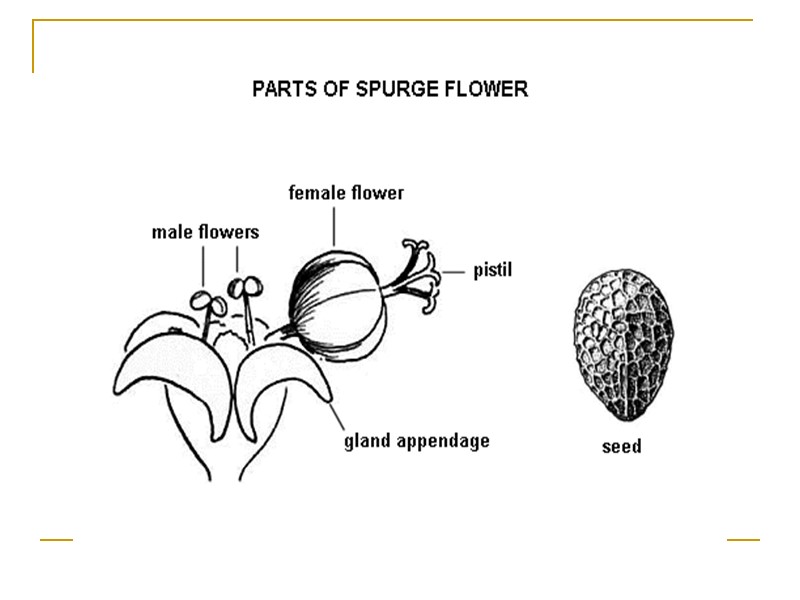
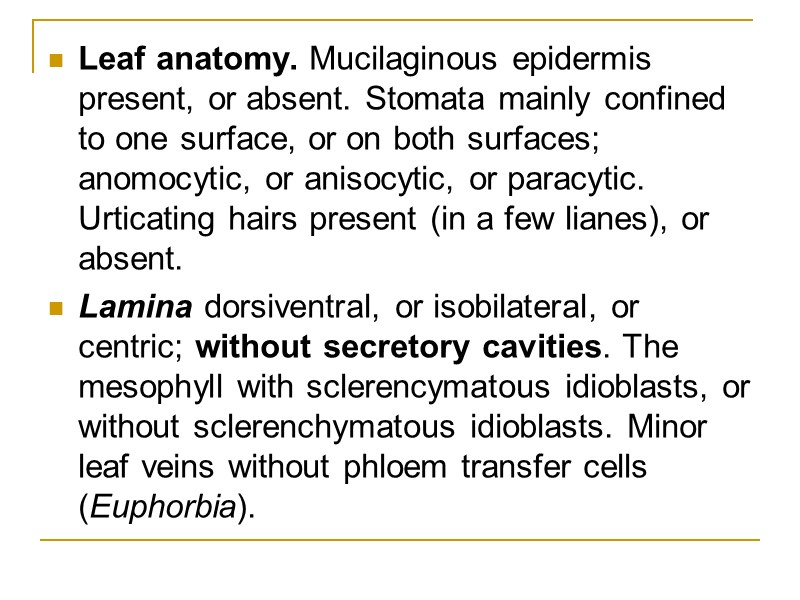
Leaf anatomy. Mucilaginous epidermis present, or absent. Stomata mainly confined to one surface, or on both surfaces; anomocytic, or anisocytic, or paracytic. Urticating hairs present (in a few lianes), or absent. Lamina dorsiventral, or isobilateral, or centric; without secretory cavities. The mesophyll with sclerencymatous idioblasts, or without sclerenchymatous idioblasts. Minor leaf veins without phloem transfer cells (Euphorbia).

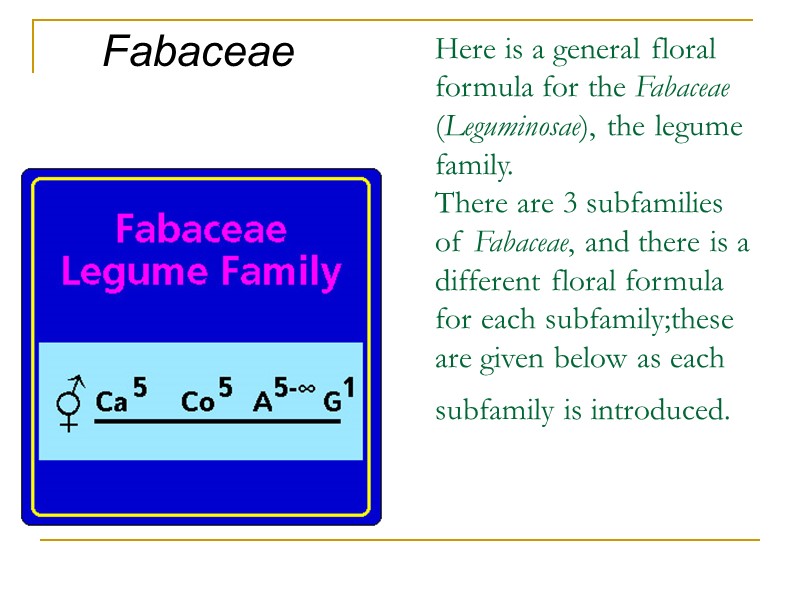
Here is a general floral formula for the Fabaceae (Leguminosae), the legume family. There are 3 subfamilies of Fabaceae, and there is a different floral formula for each subfamily;these are given below as each subfamily is introduced. Fabaceae
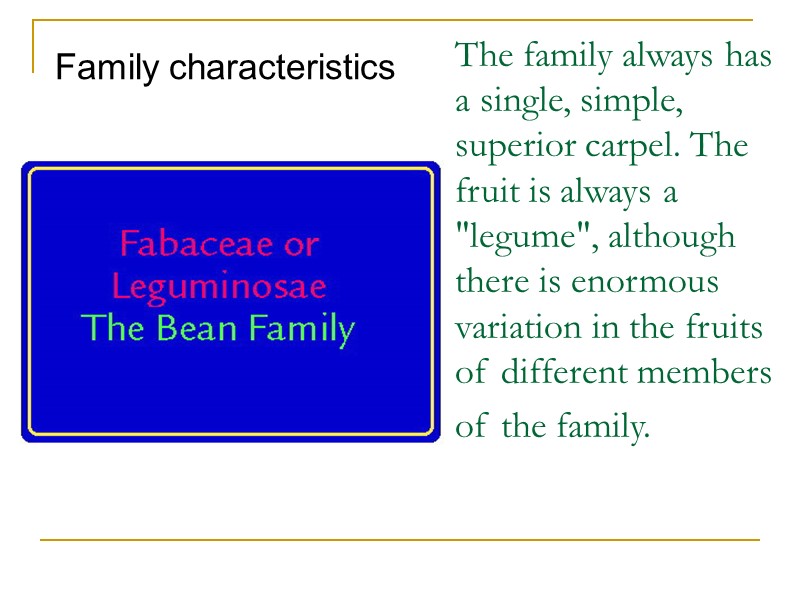
The family always has a single, simple, superior carpel. The fruit is always a "legume", although there is enormous variation in the fruits of different members of the family. Family characteristics

The Fabaceae are a very widely distributed family, common in both the tropics and in temperate regions. Distribution
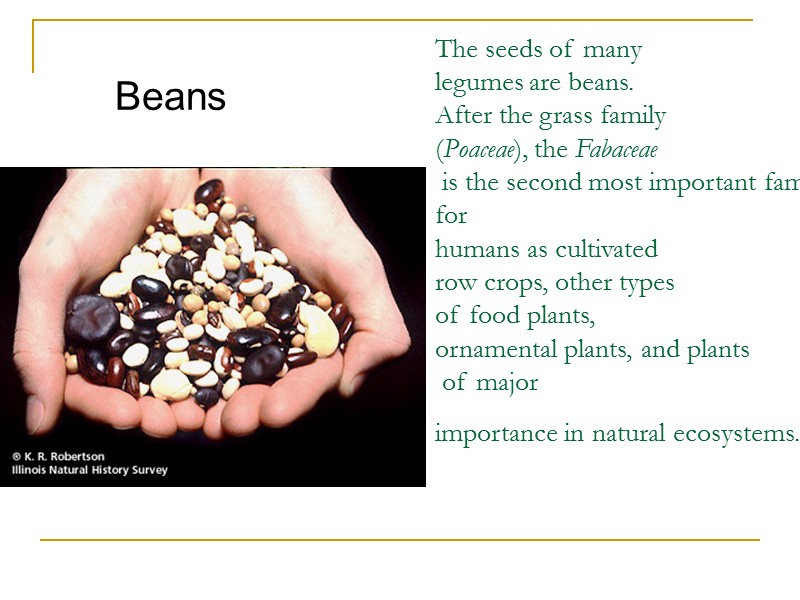
The seeds of many legumes are beans. After the grass family (Poaceae), the Fabaceae is the second most important family for humans as cultivated row crops, other types of food plants, ornamental plants, and plants of major importance in natural ecosystems. Beans
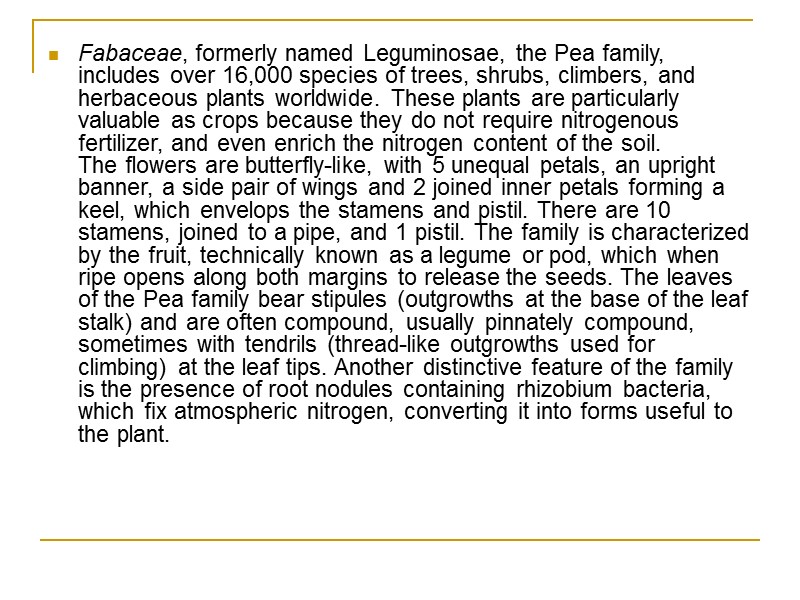
Fabaceae, formerly named Leguminosae, the Pea family, includes over 16,000 species of trees, shrubs, climbers, and herbaceous plants worldwide. These plants are particularly valuable as crops because they do not require nitrogenous fertilizer, and even enrich the nitrogen content of the soil. The flowers are butterfly-like, with 5 unequal petals, an upright banner, a side pair of wings and 2 joined inner petals forming a keel, which envelops the stamens and pistil. There are 10 stamens, joined to a pipe, and 1 pistil. The family is characterized by the fruit, technically known as a legume or pod, which when ripe opens along both margins to release the seeds. The leaves of the Pea family bear stipules (outgrowths at the base of the leaf stalk) and are often compound, usually pinnately compound, sometimes with tendrils (thread-like outgrowths used for climbing) at the leaf tips. Another distinctive feature of the family is the presence of root nodules containing rhizobium bacteria, which fix atmospheric nitrogen, converting it into forms useful to the plant.

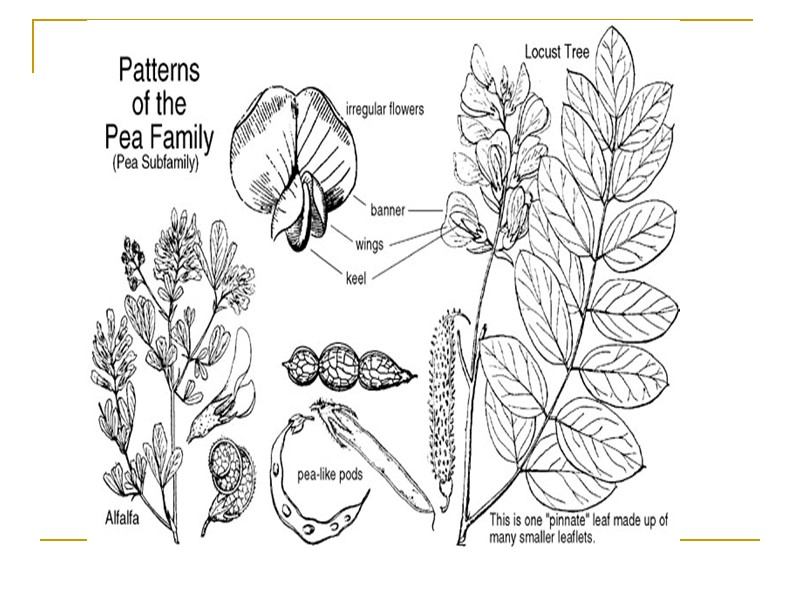

Trifolium pratense. Red Clover.

Rosaceae Spiraea subfamily, Rose subfamily, Peach subfamily, Apple subfamily

The Spiraeoideae includes mostly woody plants, shrubs and small trees, although a few members are herbaceous perennials.
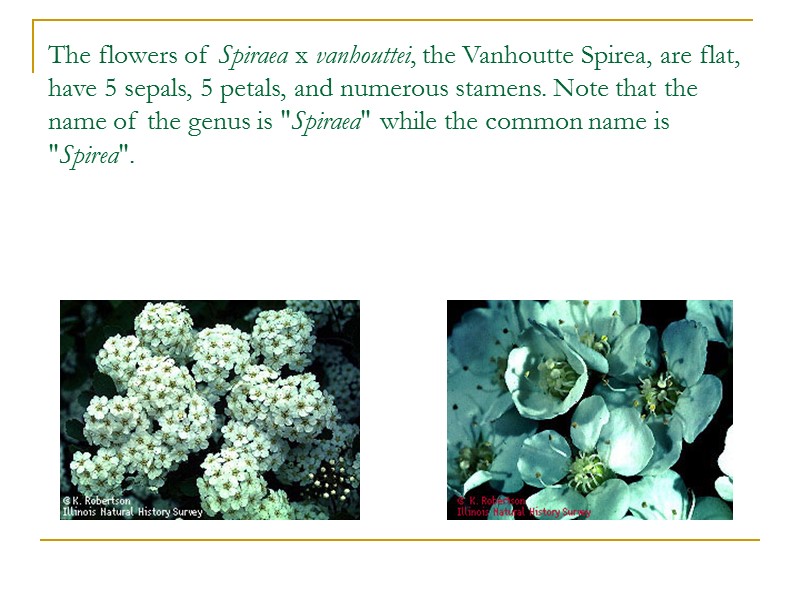
The flowers of Spiraea x vanhouttei, the Vanhoutte Spirea, are flat, have 5 sepals, 5 petals, and numerous stamens. Note that the name of the genus is "Spiraea" while the common name is "Spirea".
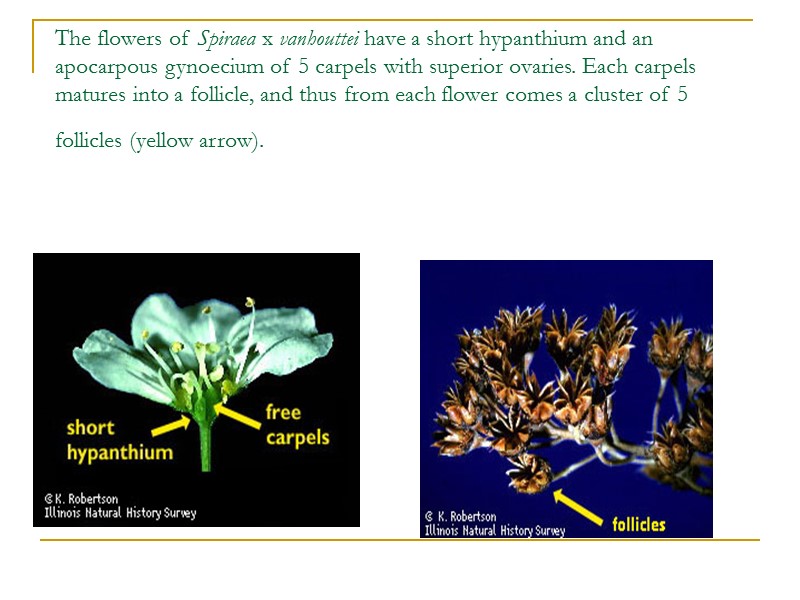
The flowers of Spiraea x vanhouttei have a short hypanthium and an apocarpous gynoecium of 5 carpels with superior ovaries. Each carpels matures into a follicle, and thus from each flower comes a cluster of 5 follicles (yellow arrow).
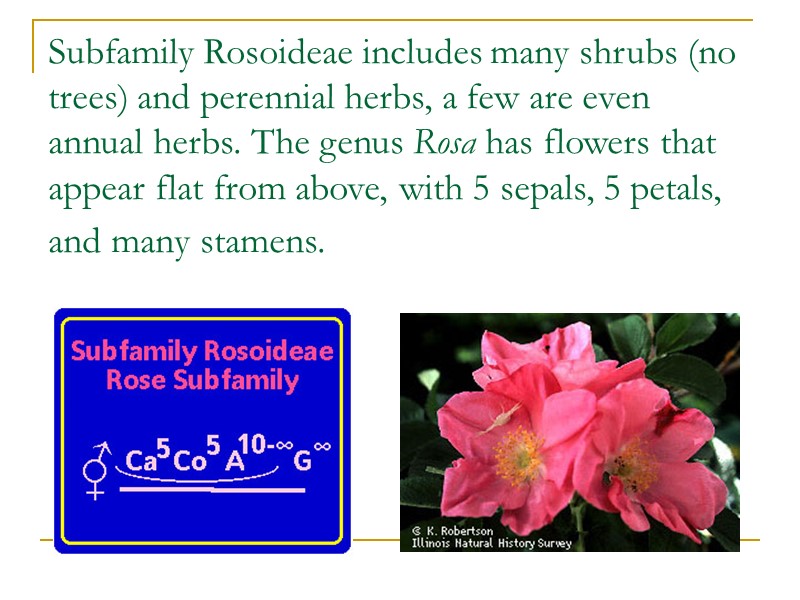
Subfamily Rosoideae includes many shrubs (no trees) and perennial herbs, a few are even annual herbs. The genus Rosa has flowers that appear flat from above, with 5 sepals, 5 petals, and many stamens.
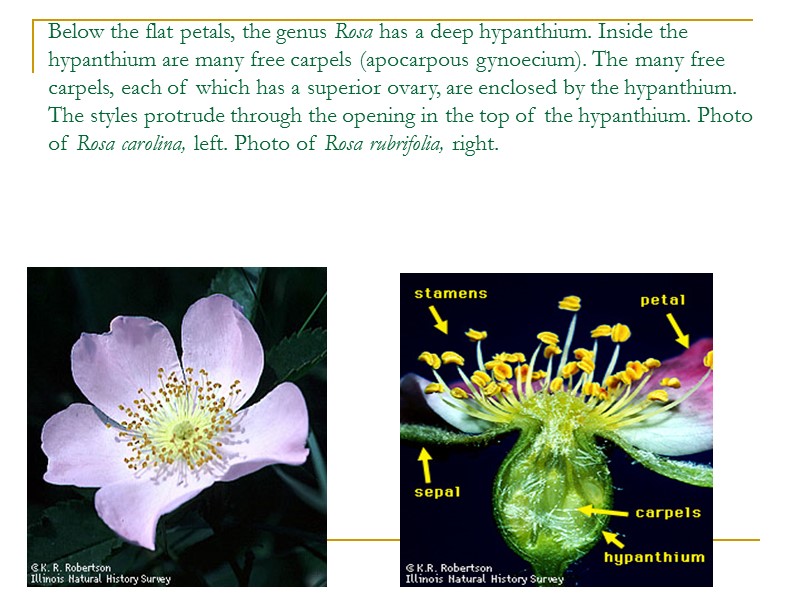
Below the flat petals, the genus Rosa has a deep hypanthium. Inside the hypanthium are many free carpels (apocarpous gynoecium). The many free carpels, each of which has a superior ovary, are enclosed by the hypanthium. The styles protrude through the opening in the top of the hypanthium. Photo of Rosa carolina, left. Photo of Rosa rubrifolia, right.
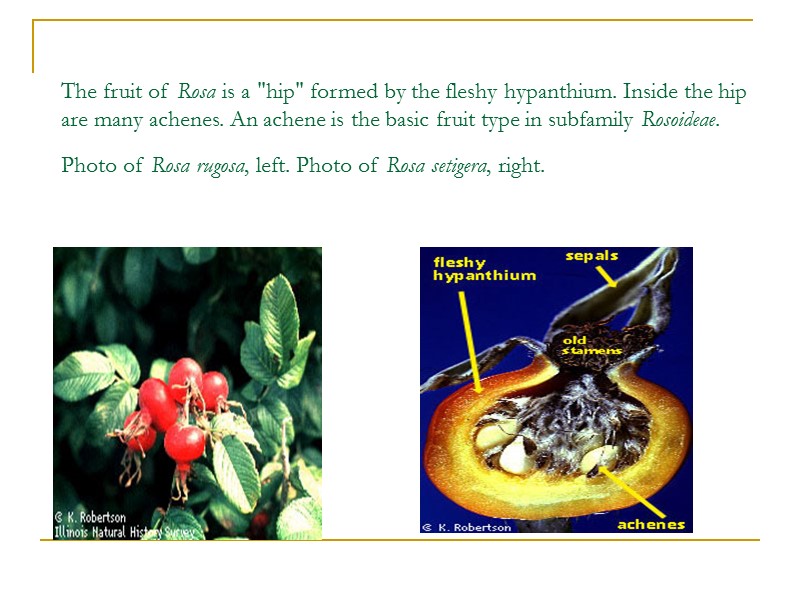
The fruit of Rosa is a "hip" formed by the fleshy hypanthium. Inside the hip are many achenes. An achene is the basic fruit type in subfamily Rosoideae. Photo of Rosa rugosa, left. Photo of Rosa setigera, right.
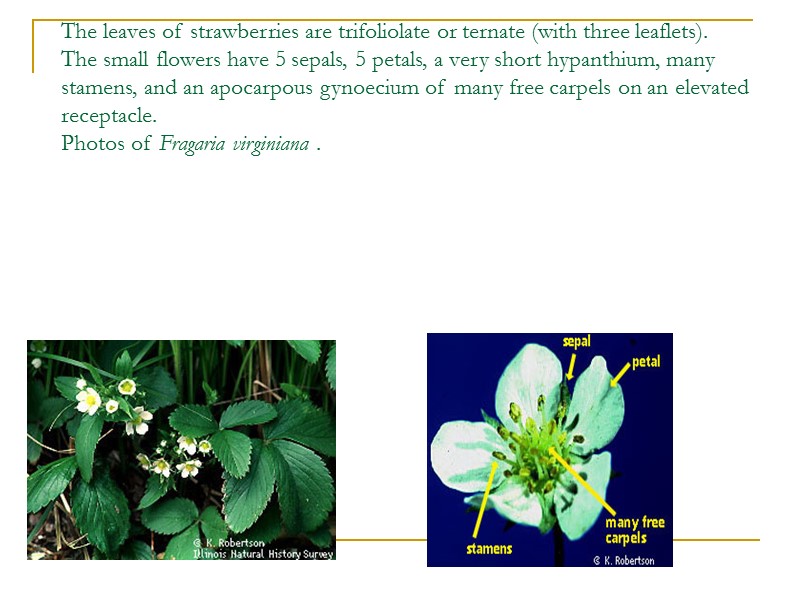
The leaves of strawberries are trifoliolate or ternate (with three leaflets). The small flowers have 5 sepals, 5 petals, a very short hypanthium, many stamens, and an apocarpous gynoecium of many free carpels on an elevated receptacle. Photos of Fragaria virginiana .
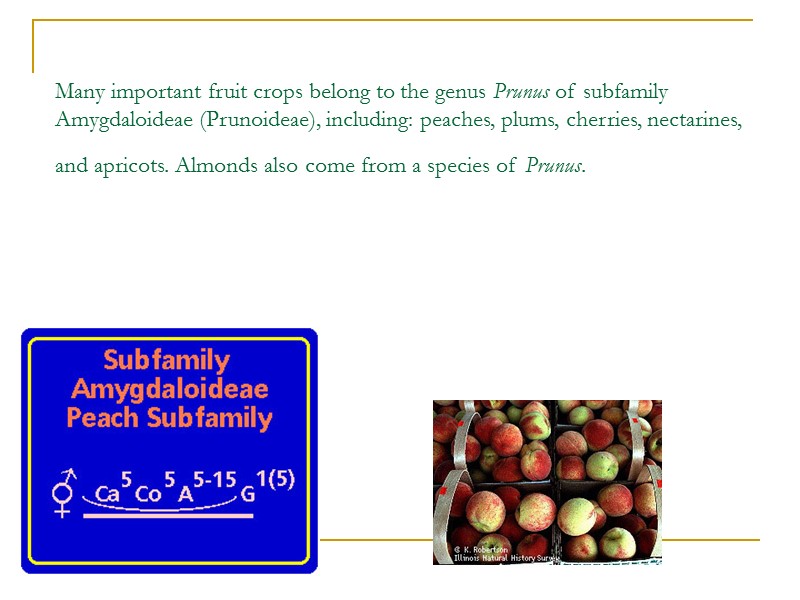
Many important fruit crops belong to the genus Prunus of subfamily Amygdaloideae (Prunoideae), including: peaches, plums, cherries, nectarines, and apricots. Almonds also come from a species of Prunus.

All members of subfamily Amygdaloideae are woody plants, either trees or shrubs. While there are perhaps five genera that belong to the Amygdaloideae, the vast majority of species are in the genus Prunus. On the left Prunus sargentii . On the right Prunus pumila.
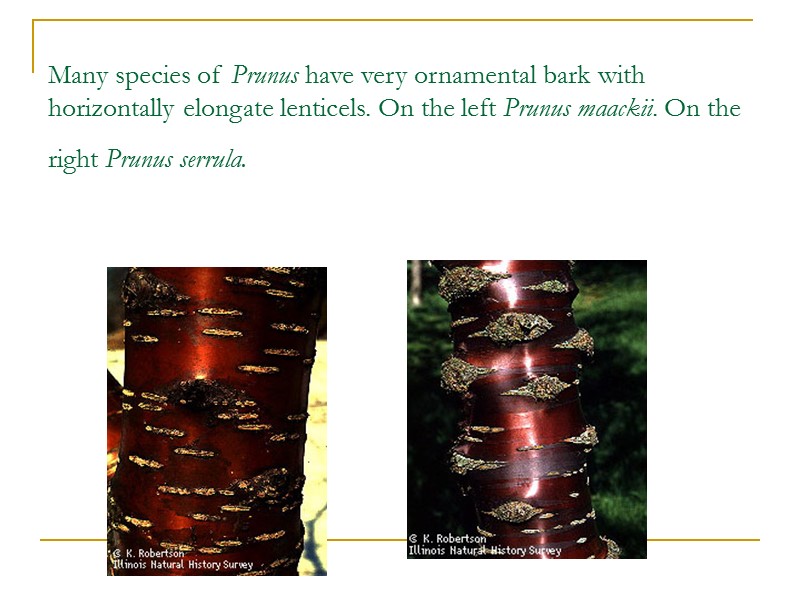
Many species of Prunus have very ornamental bark with horizontally elongate lenticels. On the left Prunus maackii. On the right Prunus serrula.
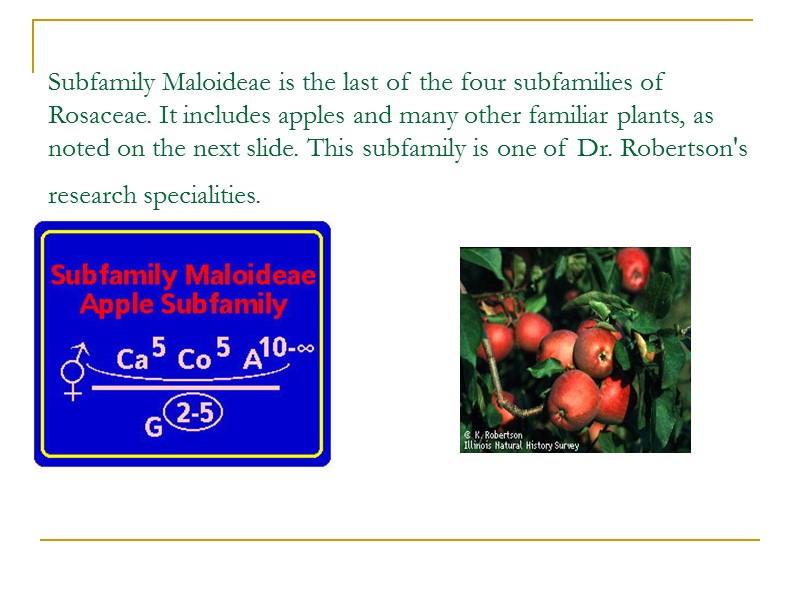
Subfamily Maloideae is the last of the four subfamilies of Rosaceae. It includes apples and many other familiar plants, as noted on the next slide. This subfamily is one of Dr. Robertson's research specialities.
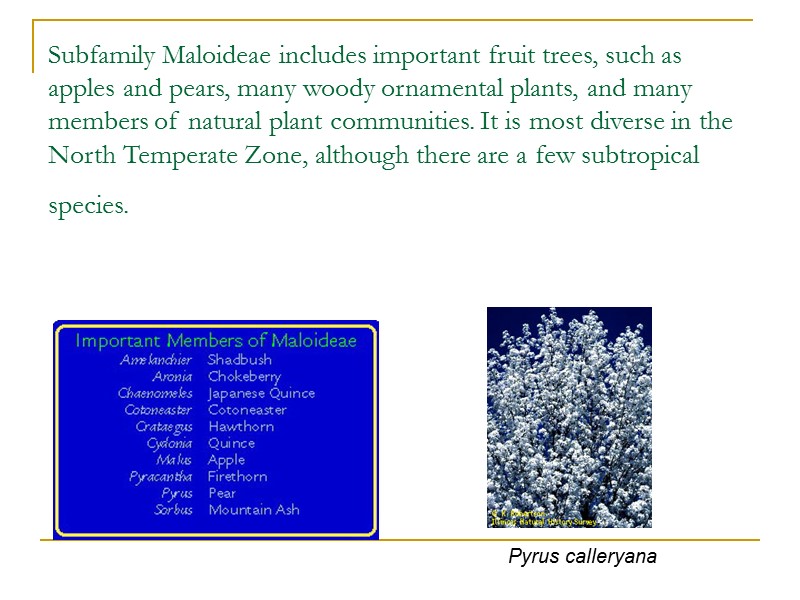
Subfamily Maloideae includes important fruit trees, such as apples and pears, many woody ornamental plants, and many members of natural plant communities. It is most diverse in the North Temperate Zone, although there are a few subtropical species. Pyrus calleryana

The flowers of subfamily Maloideae have 5 sepals, 5 petals, many stamens, a hypanthium, and (typically) a syncarpous gynoecium of 2-5 connate carpels with an inferior ovary. Malus
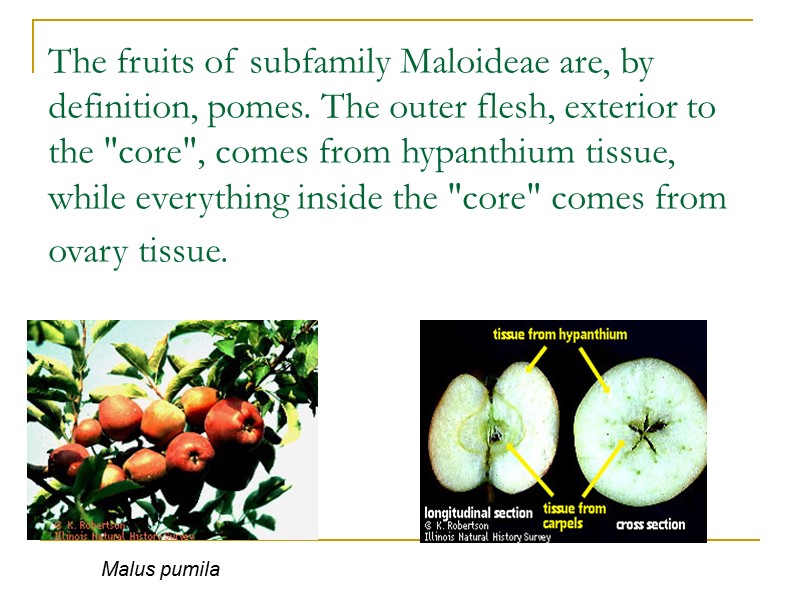
The fruits of subfamily Maloideae are, by definition, pomes. The outer flesh, exterior to the "core", comes from hypanthium tissue, while everything inside the "core" comes from ovary tissue. Malus pumila
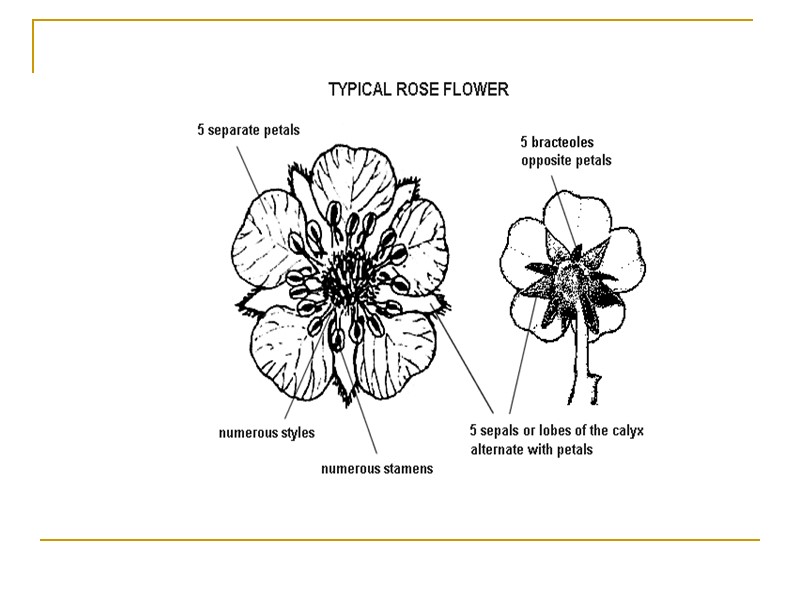
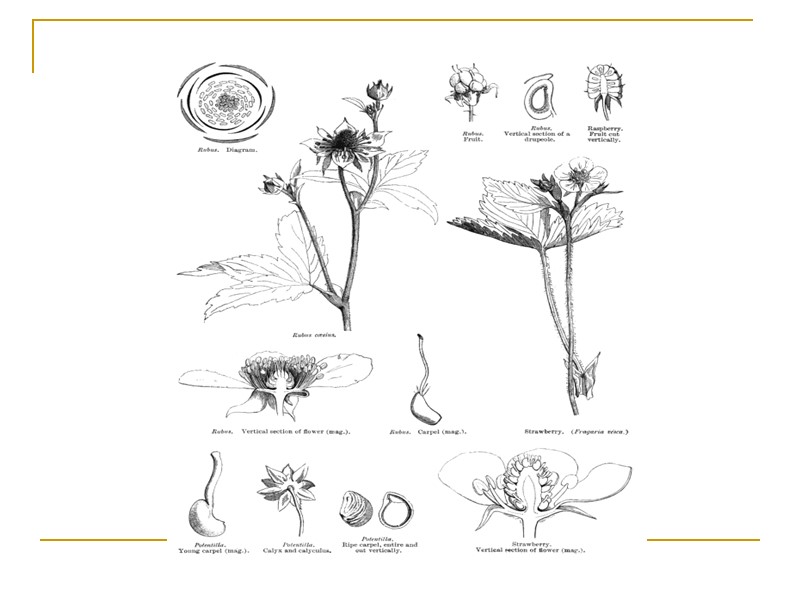
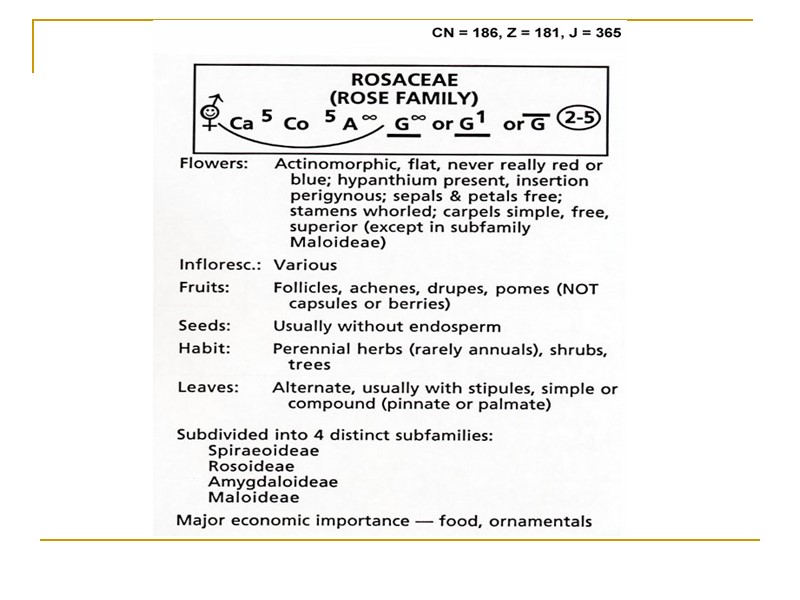
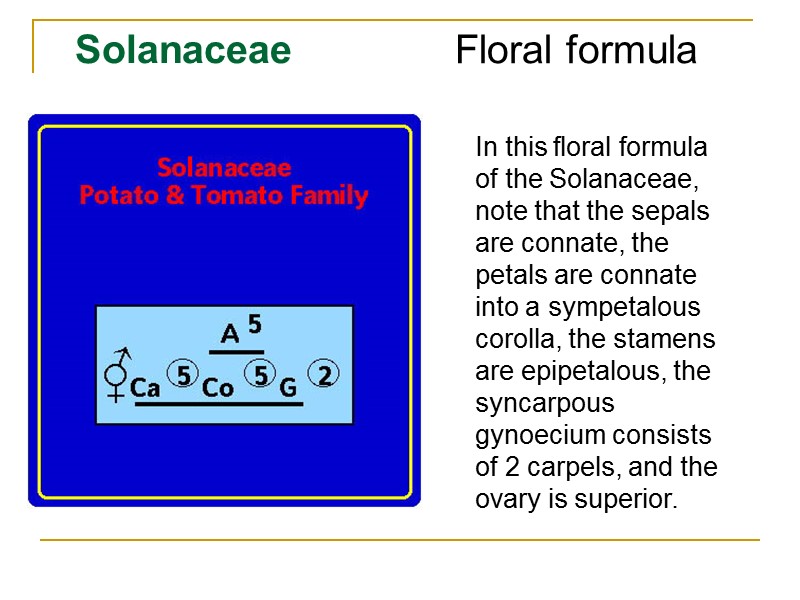
Solanaceae Floral formula In this floral formula of the Solanaceae, note that the sepals are connate, the petals are connate into a sympetalous corolla, the stamens are epipetalous, the syncarpous gynoecium consists of 2 carpels, and the ovary is superior.
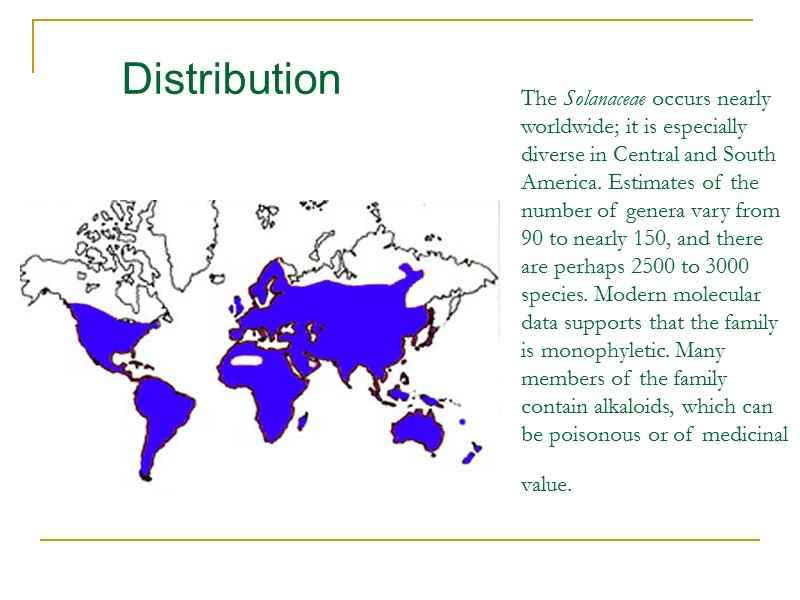
The Solanaceae occurs nearly worldwide; it is especially diverse in Central and South America. Estimates of the number of genera vary from 90 to nearly 150, and there are perhaps 2500 to 3000 species. Modern molecular data supports that the family is monophyletic. Many members of the family contain alkaloids, which can be poisonous or of medicinal value. Distribution
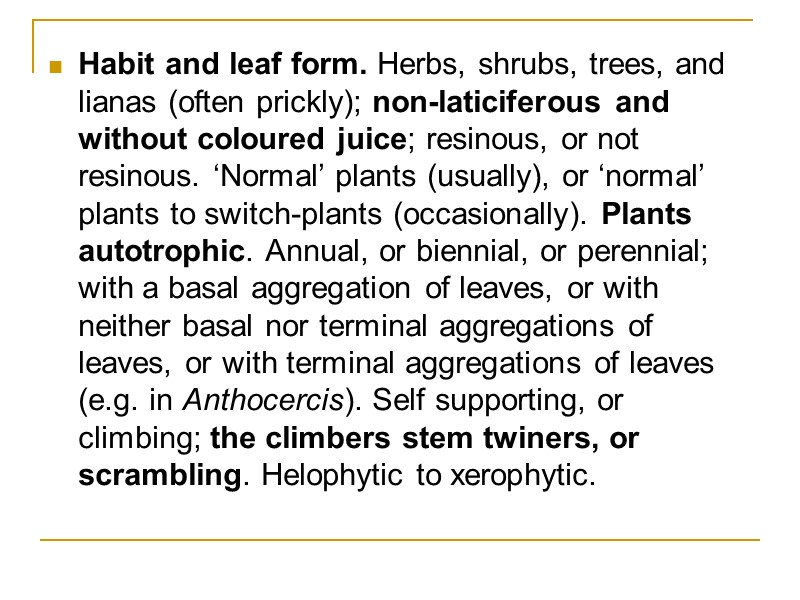
Habit and leaf form. Herbs, shrubs, trees, and lianas (often prickly); non-laticiferous and without coloured juice; resinous, or not resinous. ‘Normal’ plants (usually), or ‘normal’ plants to switch-plants (occasionally). Plants autotrophic. Annual, or biennial, or perennial; with a basal aggregation of leaves, or with neither basal nor terminal aggregations of leaves, or with terminal aggregations of leaves (e.g. in Anthocercis). Self supporting, or climbing; the climbers stem twiners, or scrambling. Helophytic to xerophytic.
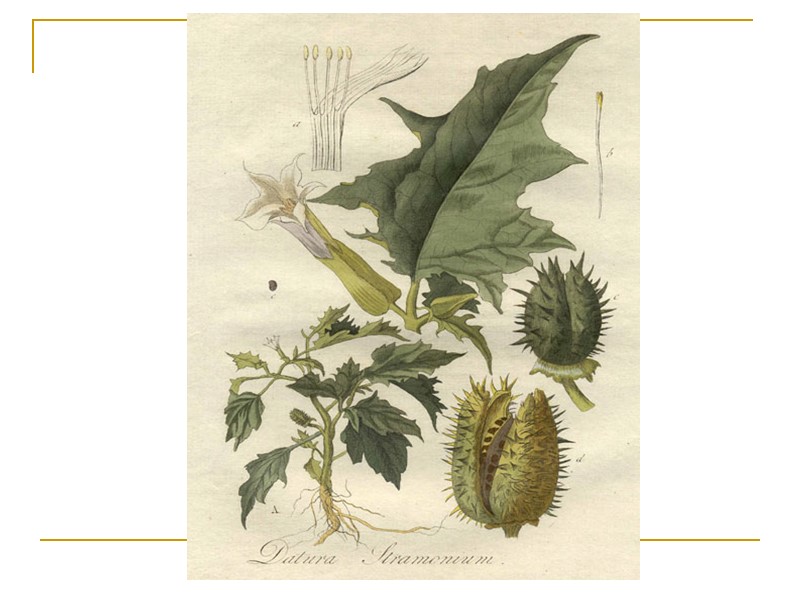
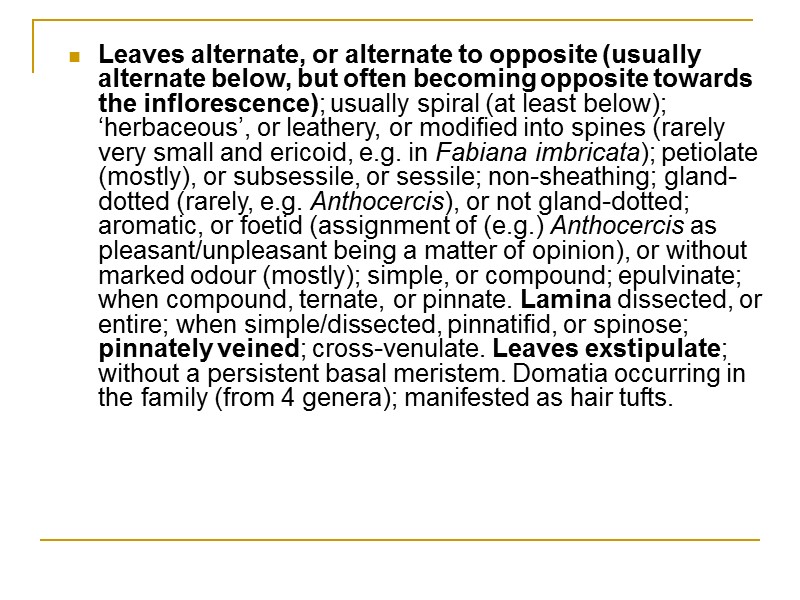
Leaves alternate, or alternate to opposite (usually alternate below, but often becoming opposite towards the inflorescence); usually spiral (at least below); ‘herbaceous’, or leathery, or modified into spines (rarely very small and ericoid, e.g. in Fabiana imbricata); petiolate (mostly), or subsessile, or sessile; non-sheathing; gland-dotted (rarely, e.g. Anthocercis), or not gland-dotted; aromatic, or foetid (assignment of (e.g.) Anthocercis as pleasant/unpleasant being a matter of opinion), or without marked odour (mostly); simple, or compound; epulvinate; when compound, ternate, or pinnate. Lamina dissected, or entire; when simple/dissected, pinnatifid, or spinose; pinnately veined; cross-venulate. Leaves exstipulate; without a persistent basal meristem. Domatia occurring in the family (from 4 genera); manifested as hair tufts.
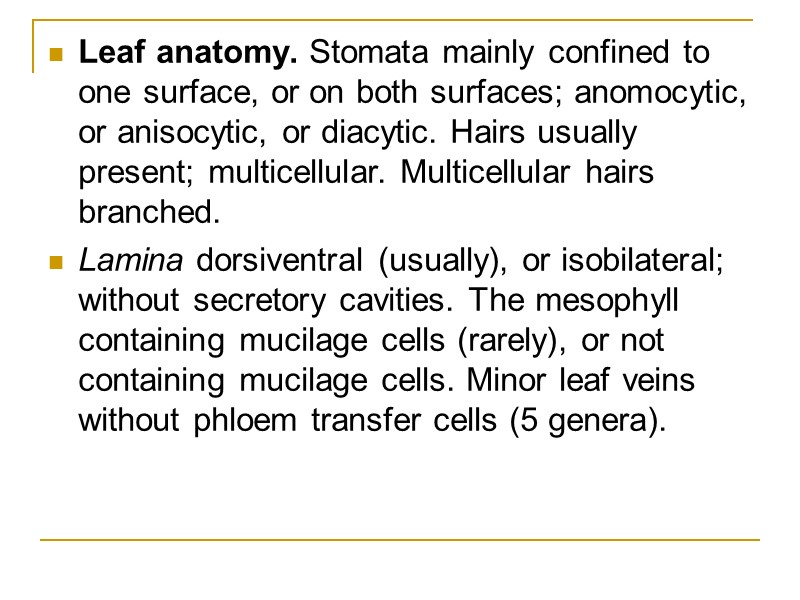
Leaf anatomy. Stomata mainly confined to one surface, or on both surfaces; anomocytic, or anisocytic, or diacytic. Hairs usually present; multicellular. Multicellular hairs branched. Lamina dorsiventral (usually), or isobilateral; without secretory cavities. The mesophyll containing mucilage cells (rarely), or not containing mucilage cells. Minor leaf veins without phloem transfer cells (5 genera).
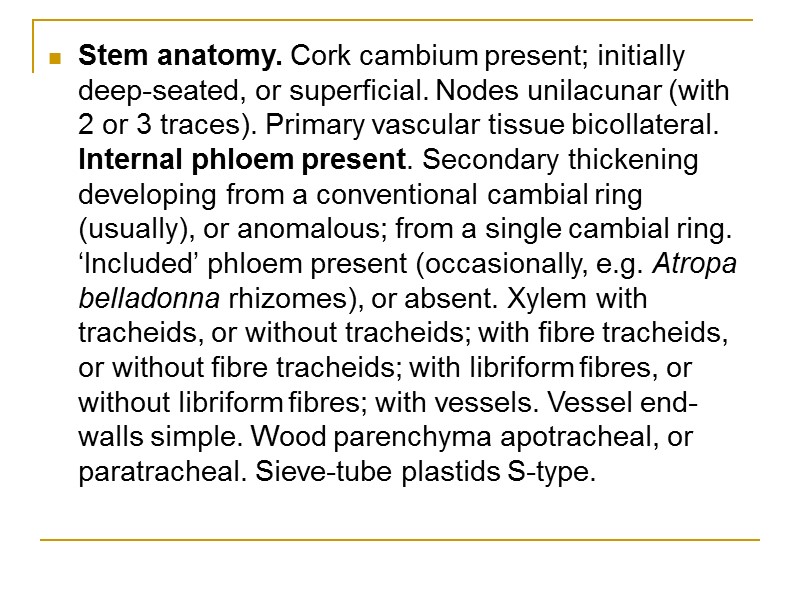
Stem anatomy. Cork cambium present; initially deep-seated, or superficial. Nodes unilacunar (with 2 or 3 traces). Primary vascular tissue bicollateral. Internal phloem present. Secondary thickening developing from a conventional cambial ring (usually), or anomalous; from a single cambial ring. ‘Included’ phloem present (occasionally, e.g. Atropa belladonna rhizomes), or absent. Xylem with tracheids, or without tracheids; with fibre tracheids, or without fibre tracheids; with libriform fibres, or without libriform fibres; with vessels. Vessel end-walls simple. Wood parenchyma apotracheal, or paratracheal. Sieve-tube plastids S-type.
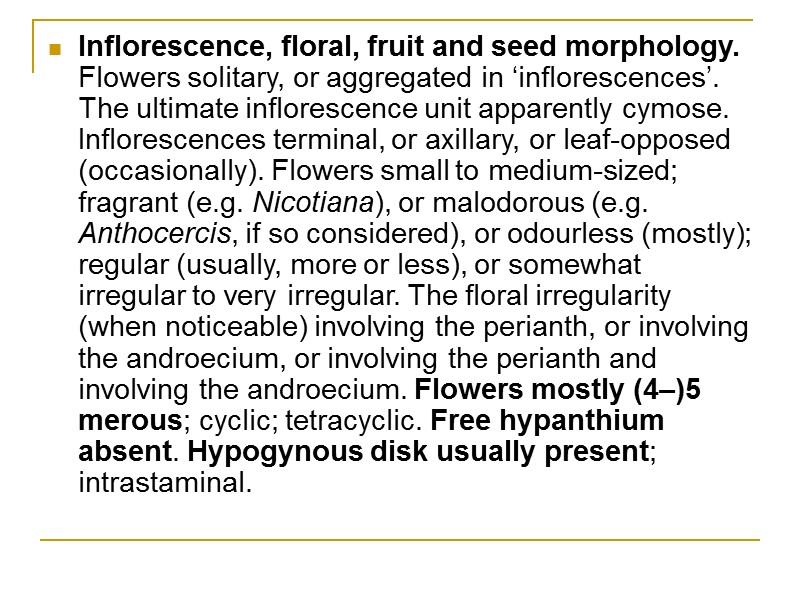
Inflorescence, floral, fruit and seed morphology. Flowers solitary, or aggregated in ‘inflorescences’. The ultimate inflorescence unit apparently cymose. Inflorescences terminal, or axillary, or leaf-opposed (occasionally). Flowers small to medium-sized; fragrant (e.g. Nicotiana), or malodorous (e.g. Anthocercis, if so considered), or odourless (mostly); regular (usually, more or less), or somewhat irregular to very irregular. The floral irregularity (when noticeable) involving the perianth, or involving the androecium, or involving the perianth and involving the androecium. Flowers mostly (4–)5 merous; cyclic; tetracyclic. Free hypanthium absent. Hypogynous disk usually present; intrastaminal.
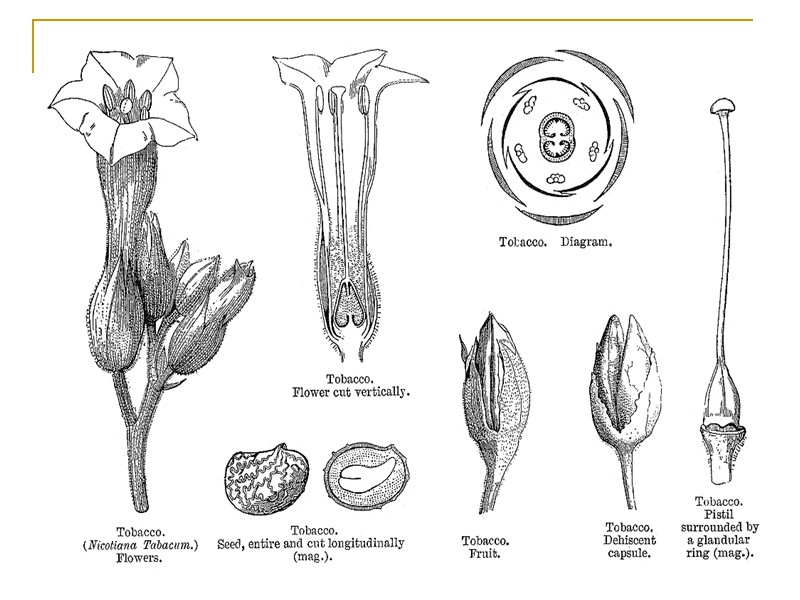

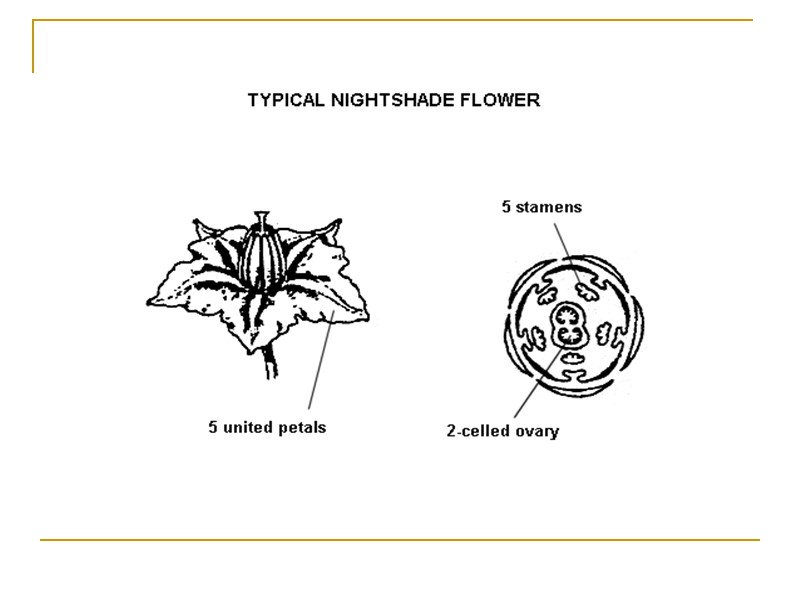
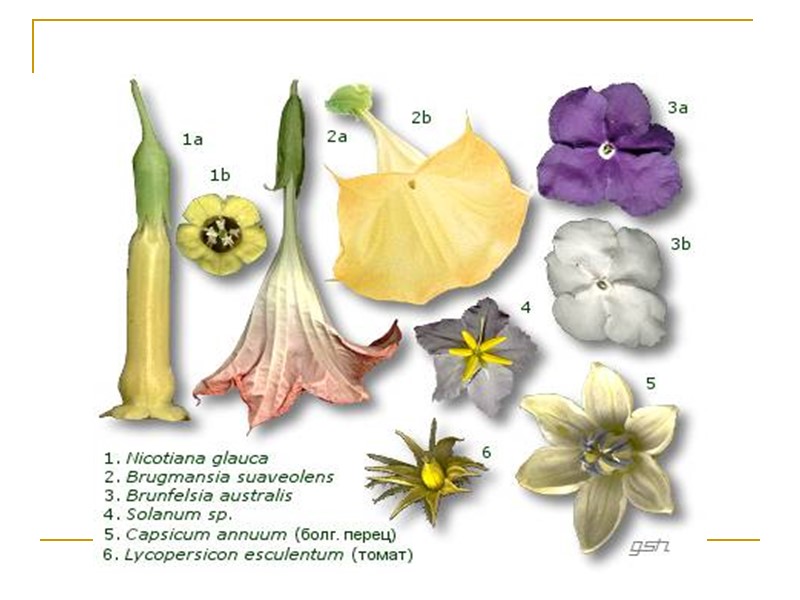
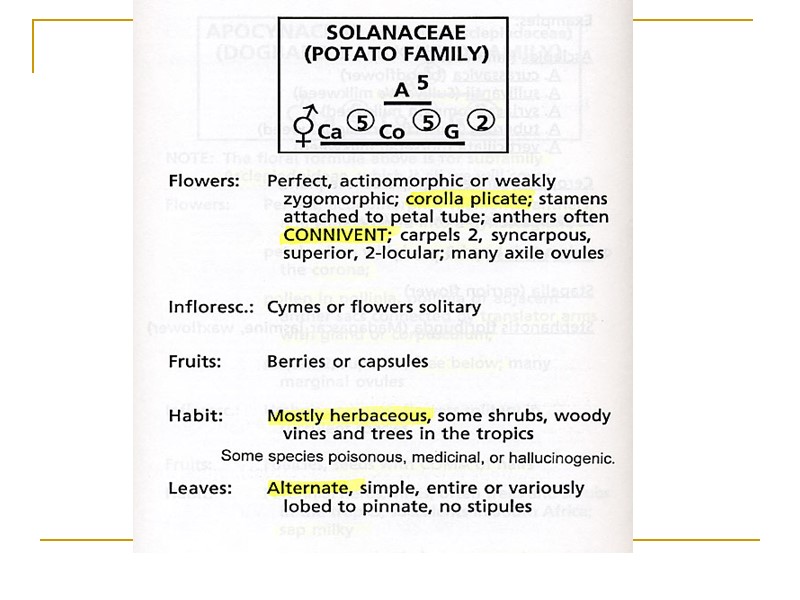
28334-2_apiac_euph_fab_ros_sol.ppt
- Количество слайдов: 68

